Earth observation satellites continue to assess the catastrophic damage in Turkey and Syria caused by a series of devastating earthquakes that occurred on February 6. Maxar Technologies shared new images of the horrific surface cracks when three lithospheric plates — the Anatolian, Arabian and African — collided on that fateful Monday.

In one of these images from space, a surface crack crosses the Turkish city of Nurdagi. Thousands of people died under the rubble of buildings. Maxar satellites also notice a gap near the city of Turkoglu, where the crack is visible at a distance of several kilometers. This is a consequence of the energy of enormous power released as a result of a series of earthquakes of magnitude 7.8 and 7.5 on the Richter scale.
NEW: @Maxar’s satellite imagery clearly reveals the multi-km-long surface rupture extending along the Gölbaşı-Türkoğlu segment of the East Anatolian Fault as a result of the 7.8 magnitude earthquake in southern Turkey. pic.twitter.com/915oWD9b1E
— Nahel Belgherze (@WxNB_) February 13, 2023
The earthquake in Turkey on February 6 was the strongest in the last few decades. Rescue operations are continuing slowly, especially on the Syrian side of the border, where the provision of assistance is complicated by years of civil war.
Earlier, European Earth observation satellites showed that the two cracks formed as a result of two major tremors last week were among the longest that geologists had ever seen, said Professor Tim Wright, Head of the British Center for Observation and Modeling of Earthquakes, volcanoes and Tectonics.
Left image: surface rupture of #turkey #earthquake Mw 7.8
Right image: surface rupture of #Kaikoura #earthquake Mw 7.8 pic.twitter.com/jgTwTvHP6x— Dr Shreya シェア (@shryaarora) February 13, 2023
The longer crack, formed by the first and more powerful earthquake of magnitude 7.8, stretched 300 km northeast of the northeastern edge of the Mediterranean Sea. A short crack with a length of 125 km, formed by a second, slightly weaker shock, runs from west to east, partially parallel to the site of the first crack. The images showed that in some parts of the crack, the ground parted to the sides by 5-30 meters.
Earlier we reported on whether it was worth being afraid of earthquakes in Ukraine.
According to Space
Follow us on Twitter to get the most interesting space news in time
https://twitter.com/ust_magazine
